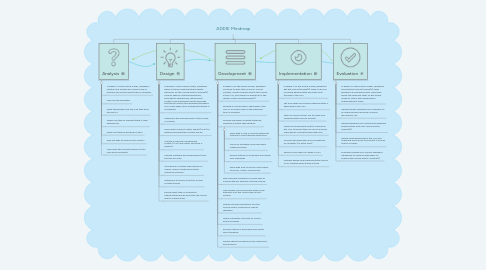ADDIE Mindmap
by Nicole Sybesma


1. Analysis
1.1. In phase 1 of the ADDIE model, designers identify and analyze key issues such as learners and overall objectives for students
1.2. Who are the students?
1.3. What technology and tools do they have access to?
1.4. Where are they as learners/what is their experience?
1.5. When will they be working on this?
1.6. Why are they enrolled in the course?
1.7. How does this course/module fit into real-world contexts?
2. Evaluation
2.1. In phase 5 of the ADDIE model, designers evaluate the course/module(s) using feedback and available data. They then revisit the different steps of the ADDIE model to retool their work before implementing it again
2.2. Review holistic feedback from learners on an ongoing basis received via email, discussions, etc.
2.3. Review feedback from structured feedback opportunities built into course and/or module(s)
2.4. Review data generated by the LMS and authoring tools about time spent in course and/or modules
2.5. Evaluate findings from various feedback categories to come up with ways to improve the course and/or module(s)
3. Implementation
3.1. In phase 4 of the ADDIE model, designers get the course/module(s) ready to go live including adding dates and other final touches in the LMS
3.2. Set due dates and module opening dates if applicable in the LMS
3.3. Test run course in the LMS to make sure implementation will be smooth
3.4. Check all components and/or modules in the LMS to ensure they are still in working order before course/module goes live
3.5. Incorporate applicable accommodations for students (i.e. extra time)
3.6. Perform final check on dates in LMS
3.7. Address design and implementation issues on an ongoing basis during course
4. Design
4.1. In phase 2 of the ADDIE model, designers figure out and make important design decisions for the course and/or module(s) such as specific learning objectives, information sequencing, determining content, and authoring tools/technology that will be used in the development phase. This is also when story boarding/outlining is completed
4.2. Determine the learning goals of the course or module
4.3. Work with a subject matter expert (SME) on determining what the content will be
4.4. Choose a learning management system (LMS) and overall structure if relevant
4.5. Choose software and development tools that will be used
4.6. Storyboard or outline with visuals for overall course if applicable and/or individual modules
4.7. Determine an overall look/feel for the course/module
4.8. Decide what type of evaluation opportunities will be built into the course and/or module itself
5. Development
5.1. In phase 3 of the ADDIE model, designers continue to work with SMEs on course content, create modules and/or the course in the LMS, and finalize all elements of the design of the course/module(s)
5.2. Develop a course shell if applicable in the LMS or an overall shell in the authoring tool for modules
5.3. Develop individual modules/materials, chunking content appropriately
5.3.1. Work with a SME on incorporating key content to meet learning objectives
5.3.2. Focus on navigation and flow while creating module
5.3.3. Ensure material is accessible and meets ADA standards
5.3.4. Work with SME to ensure information accuracy, clarity, and efficacy
